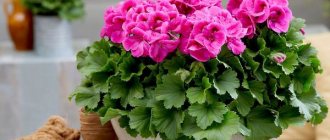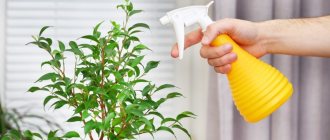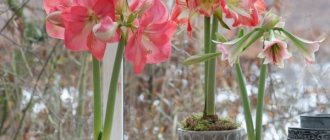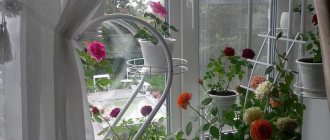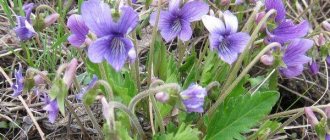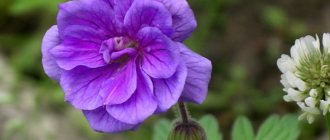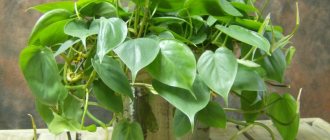The most popular houseplants of the bulbous group
Bulbous flowers are grown for cutting to create flower baskets, bouquets and spring arrangements. Many of them grow quite successfully indoors.
Hippeastrum
It is often (and incorrectly) called amaryllis. Its homeland is South America. Mostly hybrids with flowers much more beautiful than those of the original species grow in the rooms. The leaves of the hybrid hippeastrum are long, linear, the bulb is large, funnel-shaped flowers sit in 2-6 pieces on the crown of a tall and thick peduncle. Depending on the variety, they can be from pale pink to dark red, sometimes variegated, with streaks and specks. Large bulbs form two arrows.
The plant is light-loving, it needs to be given sunny places; it grows well in rooms on windows facing south, southeast, southwest. For hippeastrum to bloom, a period of deep dormancy is required. By adjusting its timing and duration, you can have flowering plants all year round.
During the rest period, I put the pot with hippeastrum in a dark place, water it rarely and little by little, just so that the soil does not dry out.
Its flowers, like those of other bulbous plants, open at different times. But there are several of them on the arrow, and therefore, in general, flowering lasts 2-3 weeks. The pot you need is not very large (the distance from the edge of the bulb to the edge of the pot should be 1.5-3 cm). In a container that is too spacious, the plant will become fatty and may not bloom for a long time.
Krinum
R
also from South America. Its leaves are long, linear, bright green. The large bulb is covered with thin light gray protective films. Fragrant white and pink flowers are collected in 6-10 pieces. Krinum usually blooms in spring or summer. Large bulbs sometimes have 2 flowers open at the same time.
Krinum needs a bright, sunny place, and the pot for it should be large. I replant old plants once every 2-3 years, and one third of the bulb should be visible from the ground.
Eucharis
Eucharis , or Amazon lily, is a very beautiful bulbous plant with beautiful white fragrant flowers. Its leaves are wide, dark, shiny, on long petioles.
Description with name and photo of indoor bulbous flowers
Bulbous flowers come in several types. Garden ones are those that are planted in the soil and grow, including wintering. Indoor heat-loving species - their bulbs tolerate only positive temperatures. Potted specimens are evergreen, which do not shed leaves during the dormant period, and bulbous - these are those that enter the dormant period with the death of the entire above-ground part.
Albuka spiral
Albuc is a herbaceous plant native to South Africa. There are many types of Albuca with flowers whose aroma resembles that of vanilla. When the crop fades, small fruits appear on it in the form of boxes with seeds.
Distinctive features of Albuka:
- round, somewhat flattened bulb (about 5 cm in diameter), painted white or light yellow;
- leaves up to 15 cm high are collected in a lush basal rosette;
- each flower has a peduncle at least 4 cm high;
- fibrous rhizome.
Interesting! When high temperatures prevail, Albuca leaves curl into a serpentine shape. Thanks to this, the plant is protected from fluid loss.
Albuka loves light, so for its intensive growth and abundant flowering, it is recommended to choose a window that faces south.
Rhodophiala (profusely flowering plant)
Rhodophiala is a bulbous plant that is not so often found in gardeners’ collections. Its homeland is Chile and Argentina, mainly in mountainous areas. About 40 species of Rhodophiala are known, and only six of them are grown in residential areas.
Features of growth:
- the bulb is in a state of suspended animation for a long time;
- a flower arrow with large flowers appears at the end of summer;
- after flowering ends, several belt-shaped leaves grow;
- For normal growth it is necessary to provide good lighting and moderate watering.
Peculiarity! Rhodofiala grows actively in any soil and tolerates low temperatures well.
Amaryllis home
Amaryllis is a crop loved by many gardeners. Its homeland is South Africa. As a houseplant, there is only one species - Amaryllis belladonna.
Features:
- long and narrow leaves of a dark green color;
- an elongated bulb with a diameter of no more than 4-5 cm;
- funnel-shaped flowers that are attached to long peduncles;
- inflorescences (up to 12 pieces) white or pink, collected in an umbrella.
The blooming period of a blooming flower is no more than a week. The flowering of the plant itself lasts 2 months - from the beginning of April to the end of May.
Vallota (with narrow long leaves)
This plant is a perennial, native to South Africa. The bulbs adapt well to flower pots and do not shed their leaves after the flowering period ends.
Distinctive features:
- on the surface of the bulb there is a dry layer of brown scales;
- dark green stems grow from the base of the stem;
- The peduncle reaches 40 cm, at its top there are up to 6-8 flowers collected in umbrella inflorescences;
- Vallota's flowering period is July, August.
Attention! The flowerpot with the bulb should be placed in a bright place all year round.
Hemanthus (with small wide leaves)
Haemanthus is a monocotyledonous bulbous plant, the genus of which includes more than 40 species. Hemanthus is native to South America. The flower reaches 40 cm, it is decorated with inflorescences of red or light cream color.
Features of growth:
- the bulbs are planted superficially in a flowerpot;
- one bulb can grow up to 6-8 fleshy leaves;
- Hemanthus loves light and moderate watering;
- Flowering period: spring, summer; leaves do not fall in winter.
Interesting! Only hybrid varieties can be grown indoors.
Amazon lily (white flowers)
The Amazon lily belongs to the Amaryllis family, which includes more than 20 species. Its homeland is Central and South America.
Distinctive features:
- foliage has a wrinkled structure with protruding veins;
- length of peduncles - up to 60 cm;
- leaf length up to 40 cm, width up to 20 cm, color – dark green;
- 2-7 wide lanceolate-shaped plates are formed on the bush;
- beginning of flowering – August, September.
Attention! Before growing the Amazon lily, it is worth considering that the plant requires a large space.
Bulbous: planting and care
Now let's talk in detail about how to care for flowering bulbous plants. They need to be watered extremely carefully, because dampness can cause the bulb to rot. It is best to use rain, river or melt water for irrigation. The pot must be chosen in such a way that it contains soil without roots, and drainage must be poured into the bottom. Spring planting of bulbous flowers should be done as follows: large plants should be planted one at a time, crocuses - six to seven, and daffodils and tulips - three. Pots with planted plants are placed in a bright and cool place. Fertilize by watering during the period of active growth or flowering.
If the leaves of the plant are dry, it means that a dormant period has begun. Then it is necessary to clean the onion from the soil, dry it and, after a month, separate the “babies” that are stored in the sand. In the fall they are planted again, and after three to four years the “babies” will take on the beauty and strength of an adult plant.
Bulbous flowers
Indoor plants and beautiful home flowers
Onions come in pale yellow, dark orange and white colors. Consequently, any flowers having such colors can be considered bulbous in color. A typical example is yellow tulips, which do not always perfectly resemble the bulb in shade, but are close in color.
Tulips are an example of bulbous bulbous flowers.
Tulips can also be white. Many of the flowers described above also have bulbous shades.
There are a lot of bulbous flowers for a garden or apartment, all of them can please the owner with their appearance. You can buy several different types and enjoy flowering almost all year round.
Diseases of bulbous plants - possible problems
| Symptoms | Causes | Remedy |
| The plant does not produce leaves or does not bloom | The bulb died as a result of a fungal disease. The affected bulbs become soft to the touch and light. Spring bulbs usually rot after thawing. | Discard the onion and wash the pot thoroughly. Plant bulbous plants in a clean substrate without impurities. |
| The plant has put out leaves, but does not bloom | improper storage, especially at high temperatures, leads to the death of the flowering parts of the bulbs, although the tissues responsible for leaf growth are preserved. Small, weak bulbs may not have enough cells to flower. The presence of rich foliage and sparse flowers may be the result of the use of nitrogen fertilizer | try to buy fresh onions that have not been left on the shelves. Choose large specimens. |
| Leaves appear at the edges of the pot | the bulb or tuber was planted with the top down. | the tops of the bulb or tuber usually have a pointed shape. If you can't tell where the top of the bulb is, it's best to plant it sideways in the ground. |
| Leaves grow slowly, buds fall off without opening | dry air, sudden change in conditions. | increase watering and humidity. Do not move plants during bud stage. |
| The leaves are succulent and grow well, but unopened buds are dropped | too abrupt a transition from cold to warm conditions | Having taken spring-flowering bulbs out of a cold place, send them for 1 week to a cool, but not warm, room. The transition from cold to warm conditions should be gradual. |
| Plants grow large and unstable | too warm conditions at an early stage of growth or lack of light. | place the bulbs close to each other - this will help slow down their growth; place in a cooler room. Do not place in a warm place until the buds begin to open. Light-loving plants are drawn to bright light. |
| Unhealthy leaves, with small yellowish spots | spider mite | Remove affected plants as the mite may spread to other plants |
Why don't they bloom
Often gardeners are faced with a problem common to all bulbous plants - houseplants refuse to bloom. Usually this problem is associated with deficiencies in care and, most often, with the lack of a quality rest period.
In addition, the following possible reasons for the lack of flowering:
- keeping at too low a temperature (do not forget that all bulbs are heat-loving);
- lack of light;
- lack of fertilizing;
- pest damage, diseases.
To cope with the problem, you need to mobilize and intensify care for the plant. It is important to create comfortable conditions for the bulbous flower: warmth, sufficient lighting, nutritious, loose soil; watering should be done moderately and only with warm water.
Also organize regular fertilizing with complex formulations. And to stimulate the plant to bloom and activate its vitality, spray the flower with the following preparations:
So, we got acquainted with the most popular and decorative representatives of bulbous plants used in indoor floriculture. The choice is rich - in the article we listed only some of the worthy representatives of bulbous plants; in fact, a much larger number of them are suitable for home breeding. Graceful bulbs will become a real decoration of the interior, will make any apartment more comfortable and will delight you with magnificent flowering.
The beauty and sophistication of bulbous flowers is admired in spring, autumn and summer, but, unfortunately, for some plants of this type, the Russian climate is too harsh. It’s good that you always have the opportunity to surround yourself with these lovely flowers. Just buy indoor bulbous flowers, and there will always be spring on your windowsill! Moreover, there are plants recommended by experts that bloom in spring - more details here!
Planting and care features for bulbous plants
When planting bulbous plants, the choice of pot is very important. It is best to choose a container made of lightly fired clay with thin porous walls that are not glazed on the inside; by the way, you can make a clay pot with your own hands at home without special equipment. The size of the container is selected based on the size of the onion. The pot is selected correctly when there is 1.5 cm of free space on each side from its walls to the plant. Bulbous plants do not like waterlogging, so there must be a hole to drain the water. The diameter of the pot should be equal to its height. For planting, use a regular substrate for flowering plants, not forgetting to provide drainage: place a layer of expanded clay or broken brick on the bottom of the pot. In addition, in order to provide the plant with a good outflow of moisture and at the same time facilitate the flow of air to the roots, the pots with plants can be slightly raised above the surface of the windowsill. Bulbous flowers develop well in a bright but not hot room. The optimal temperature during the growing season is 20-25 degrees. They prefer moderate watering, they like melt or rain water, but ordinary tap water, pre-settled for 24 hours, is also suitable. Water temperature is room temperature. Bulbous plants respond well to feeding with liquid fertilizers containing nitrogen, potassium and phosphorus. They should be fed only during the flowering and growth period, once every two weeks.
A feature of the successful cultivation of this type of plant is to provide it with a period of rest. The rested bulbs will begin to form leaves with renewed vigor, and the plants will bloom regularly and profusely. Each species has its own wintering conditions, but, in general, it all comes down to stopping fertilizing, reducing watering and storing the bulbs in the substrate at a temperature of at least 10 degrees
Hemanthus
An evergreen ornamental plant belonging to the amaryllis family. The plant is found in the wild exclusively in South Africa; it does not grow “wild” anywhere else in the world (see photo).
It is popularly called “elephant tongue” for its rough and very wide leaves. In indoor floriculture, two hybrid varieties are usually used:
The second species blooms in a very unique way: together with its petals there is a cluster of snow-white stamens with yellow tips.
Hemanthus Catarina has red flowers. Translated, the name of the plant means “bloody flower,” which is quite consistent with its bright red, richly hued petals. But the white-flowered version is more popular in indoor floriculture. The flowering period of hemanthus is late summer-early autumn.
Both species are easy to care for; watering is required moderately, and during the dormant period, even infrequently. The foliage remains green and decorative all year round. This plant does not grow tall; usually the height of the hemanthus does not exceed 40 cm.
Hemanthus cannot be kept in direct sunlight - its leaves can burn and dry out at the tips. Therefore, on the southern window sill, shade the window with paper or light cloth. Complex formulations for bulbous plants are suitable as feeding; during the growing season, hemanthus is fed two to three times. In winter, a period of rest is needed with maintenance at a temperature of +15-18 degrees.
Bulbous perennials blooming in summer
Bulbous perennial flowers have a special aroma and color range, which are distinguished by their long flowering in the summer and the size of their buds.
Lilies
Garden lily is a bright representative of bulbous perennials, which is represented by at least 80 species. All lilies are similar in the type of inflorescence, which has a cylindrical shape, and the presence of many flowers on it (up to 16 pieces). The most common varieties are:
- Asiatic lily;
- Martagon;
- Candidum.
Gabranthus (Argentine lily)
Upstart - this is how gabranthus is popularly called, since only 3 - 5 days pass from the moment the first foliage appears to flowering. This is an original perennial flower, from each bulb of which about 3 - 4 buds grow. The main feature of the plant is that it is completely unpretentious in terms of cultivation and can be cultivated not only in flower beds, but also at home.
Garden bows
Ornamental onions are also often found in garden plantings. In total, the bulbous plant has at least 400 species, so gardeners always have a chance to choose exactly the variety that is most suitable for a particular landscape design. All onions bloom for a long time, so they can be planted both in individual plantings and in group plantings. Among the varieties are:
- Aflatunsky;
- Gladiator;
- Eros;
- Roundhead;
- Blue;
- Moly;
- Quinn;
- Unifolium.
Montbrecia
Crocosmia, or Montbrezia, will be a wonderful decoration for any garden in the summer. The bulbous perennial amazes with the brightness of its flowers and is suitable for growing not only as a decoration for flower beds, but also for cutting (can stand in water for more than 2 weeks). Among the most popular types are:
- Crocosmia golden;
- Crocosmia massonorum;
- Paniculata;
- Potsa vulgare.
Galtonia (African hyacinth)
Galtonia belongs to the Liliaceae family. In nature, there are only 4 species of this flower, of which the white variety is the most popular. The perennial grows to impressive sizes (more than 1 meter), and on each of its bushes bloom from 10 to 15 flowers, which are drooping inflorescences.
- Galtonia whitish;
- Galtonia is excellent;
- Green-flowered Galtonia.
Important! This species does not tolerate cold weather, so it is important to dig up bulbs for the winter, even in regions with a fairly mild climate.
Types of bulbous perennials
Garden bulbous perennial flowers include many types of plants that differ not only in external characteristics, but also in their flowering period.
There are several types of bulbous perennials:
- corms;
- small-bulbous;
- bulbous.
All of them belong to perennials, the underground part of which (bulbs) retains all the necessary microelements and nutrients for flower growth.
When choosing perennials, you should pay attention to the seasonality of flowering to ensure its continuity when laying out the site:
- Spring specimens and primroses. The earliest flowers include perennials such as crocus, scilla, maskari, and snowdrop. With the onset of warm weather, daffodils, tulips, irises and hyacinths bloom.
- Summer bulbous. In the summer months, larger flowers with a stunning aroma and a variety of colors can be seen in the flower beds. These are lilies, dahlias, daylilies, callas, gladioli, freesia, etc.
- Autumn perennials. Flowers that are not afraid of cold weather and continue to delight the eyes of others are crocuses, crocuses and cyclamen.
To choose the right varieties, you need to carefully study not only the characteristics of bulbous perennials, but also look at their photographs. This will help in creating an original planting that will bloom almost continuously.
Useful tips for flower growers
Those who have been growing bulbous crops for a long time know that even from rarely flowering species it is possible to achieve more regular flowering, more often than 1-2 times a year. If you properly care for the plantings, the dormant period will be slightly shortened. However, the main thing here is not to overdo it, since any plant needs rest, otherwise it will be exhausted. Here's what experienced flower growers recommend:
- when the flower has dropped its leaves and buds, it should be put in a shaded place and rarely watered. The amount of water needs to be reduced by 2-3 times;
- It is best to use rain or melt water for irrigation; you can use settled or filtered water;
- Water the areas located near the walls of the pot; water should not fall on the stem. Excess water from the pan must be drained;
- The first fertilizing with potassium sulfate (or any potassium salt) is carried out as soon as the first arrow appears. When using complex additives, you need to carefully study the composition; potassium should be in greater quantities than nitrogen. Fertilizers are applied only in diluted form and into already moistened soil;
- It is necessary to replant the bulbs only as a last resort, when they have increased significantly in volume and the old pot becomes very crowded.
If you grow a flower for years, then after a couple of years several bulbs will form at its base. They are dug up and planted. the largest specimens will bloom after a year, and the small ones only after 1.5-2 years.
Attention!
The bulbs need to be replanted on the day of digging; they should not be allowed to dry out completely.
Flowering indoor bulbous plants with lush, juicy buds make everyone around you fall in love with them at first sight. Despite the short duration of such a bright flowering, the number of their fans does not decrease, but, on the contrary, only increases every year. Even a faded plant with green leaves enlivens the house and harmonizes with any interior, refreshing it.
Amaryllis: botanical description and appearance
Amaryllis is one of the genera of the Amaryllis family. Linnaeus identified this genus in 1753, although the flower was known to Europeans earlier, under the name lionnarcissus.
But the greatest taxonomist made a serious mistake when he classified hippeastrums, similar flowers, also from this family, as amaryllis. This went on for many years, until the hippeastrums were separated into a special genus. But even now, many flower lovers confuse these two completely different species. However, they have a good excuse, because Linnaeus himself confused the plants!
And distinguishing them, in fact, is not so difficult. There are several sure signs, let’s name just three:
- The amaryllis peduncle is filled inside with soft tissue, while in hippeastrums it is hollow;
- Amaryllis flowers have a pronounced smell, while hippeastrum flowers have no smell, or smell very weakly;
- On the peduncle of amaryllis there are from 8 to 12 flowers, in hippeastrum there are no more than 6, and they are larger.
But let's return to our hero! He is originally from the Cape region of Africa. Many people believe that Africa is a very warm, even hot, continent. And this is generally true. But there are areas here where the climate is not so warm. One of them is the extreme southwest of the continent, where the waters of the Indian and Atlantic oceans meet. The narrow coastal strip has a climate similar to the Mediterranean: with cool winters and alternating dry and hot seasons. Here is the homeland of many endemic plants, including amaryllis.
Amaryllis is a typical perennial bulbous plant. It has narrow, several centimeters, but long leaves, growing from a pear-shaped bulb, with a diameter of 8 to 12 cm. It produces a long, strong peduncle, sometimes two at once. On the peduncle there is an inflorescence of funnel-shaped flowers, from 6 to 12, each with a diameter of 4 to 8 cm. The flowers are six-petaled, with a characteristic pointed tip. As already noted, they have a pleasant, fragrant smell, and a wide variety of colors.
As the amaryllis fades, it loses both its leaves and peduncle, gradually going into a dormant state. At this time, the Cape Region is cool and dry, and this feature should be taken into account when growing home amaryllis flowers.
Amaryllis varieties
Until recently, it was believed that amaryllis were represented by only one species. But recent changes in taxonomy have led to the identification of four species within the genus. However, only one of them is used for home maintenance - Amaryllis belladonna.
Finding a real “belladonna” is a great success for an amateur florist! The thing is that only bulbs of varieties created by people go to markets and stores. Moreover, many of these varieties are hybrids of amaryllis and hippeastrum (still, fate does not separate these plants!). Breeders strive to:
- develop varieties with double and simple flowers;
- create hybrids with unusual flower shapes: with narrow and corrugated petals (spiders), with petals with a forked end, etc.;
- find more and more new color options;
- obtain hybrids with extra-large, or, conversely, unusually small flowers.
Along with new varieties, old, classic varieties are also valued among connoisseurs: Hathor; Durbar; Parker.
